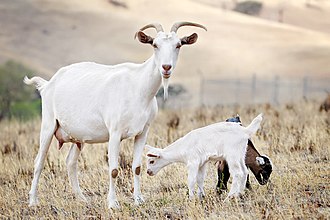Mammalian reproduction





Mammalian reproduction refers to the biological process by which new offspring are produced by mammals. This complex process varies significantly among different mammalian species but shares common features such as internal fertilization, gestation, and live birth, with the exception of monotremes, which lay eggs. Mammalian reproduction is a critical area of study in biology, veterinary science, and medicine, providing insights into the reproductive health and conservation of various mammal species.
Overview[edit]
Mammalian reproduction involves several key stages: sexual maturity, mating, fertilization, gestation, and birth. Mammals are characterized by their reproductive strategies, which include the development of a placenta in placental mammals, a feature that distinguishes them from other vertebrates.
Sexual Maturity[edit]
Sexual maturity in mammals marks the age or stage at which an individual is capable of reproducing. This varies widely among species and is influenced by factors such as genetics, nutrition, and environmental conditions.
Mating Systems[edit]
Mammals exhibit a variety of mating systems, including monogamy, polygyny, and promiscuity, each of which has evolved to maximize reproductive success under different ecological conditions.
Fertilization[edit]
Fertilization in mammals is internal, with sperm being deposited in the female reproductive tract during copulation. Some species have developed unique adaptations to enhance fertilization success, such as sperm competition and cryptic female choice.
Gestation[edit]
Gestation is the period of development of the offspring inside the female's uterus. The length of gestation varies significantly among species, from about 12-13 days in some rodents to 22 months in elephants.
Birth and Postnatal Care[edit]
Birth in mammals can be a solitary event or may involve complex social structures, depending on the species. Postnatal care is crucial for the survival of the offspring, with many species exhibiting maternal care, and in some cases, paternal care or alloparenting.
Reproductive Anatomy[edit]
The reproductive anatomy of mammals is specialized to support internal fertilization and gestation. Females typically have two ovaries, a uterus, and a complex system of ducts and glands. Males have testes, which produce sperm, and a system of ducts and glands for sperm delivery.
Reproductive Health[edit]
Reproductive health is a significant concern in both wild and domestic mammal populations. Issues such as infertility, sexually transmitted diseases, and reproductive system cancers can impact individual health and species survival.
Conservation and Management[edit]
Understanding mammalian reproduction is essential for the conservation and management of endangered species. Reproductive technologies, such as artificial insemination and embryo transfer, are increasingly used in conservation efforts.
Conclusion[edit]
Mammalian reproduction is a vital area of study that encompasses a wide range of disciplines. The diversity of reproductive strategies among mammals highlights the complexity of life and the adaptability of species to their environments.

Ad. Transform your life with W8MD's Budget GLP-1 injections from $75


W8MD offers a medical weight loss program to lose weight in Philadelphia. Our physician-supervised medical weight loss provides:
- Weight loss injections in NYC (generic and brand names):
- Zepbound / Mounjaro, Wegovy / Ozempic, Saxenda
- Most insurances accepted or discounted self-pay rates. We will obtain insurance prior authorizations if needed.
- Generic GLP1 weight loss injections from $75 for the starting dose.
- Also offer prescription weight loss medications including Phentermine, Qsymia, Diethylpropion, Contrave etc.
NYC weight loss doctor appointmentsNYC weight loss doctor appointments
Start your NYC weight loss journey today at our NYC medical weight loss and Philadelphia medical weight loss clinics.
- Call 718-946-5500 to lose weight in NYC or for medical weight loss in Philadelphia 215-676-2334.
- Tags:NYC medical weight loss, Philadelphia lose weight Zepbound NYC, Budget GLP1 weight loss injections, Wegovy Philadelphia, Wegovy NYC, Philadelphia medical weight loss, Brookly weight loss and Wegovy NYC
|
WikiMD's Wellness Encyclopedia |
| Let Food Be Thy Medicine Medicine Thy Food - Hippocrates |
Medical Disclaimer: WikiMD is not a substitute for professional medical advice. The information on WikiMD is provided as an information resource only, may be incorrect, outdated or misleading, and is not to be used or relied on for any diagnostic or treatment purposes. Please consult your health care provider before making any healthcare decisions or for guidance about a specific medical condition. WikiMD expressly disclaims responsibility, and shall have no liability, for any damages, loss, injury, or liability whatsoever suffered as a result of your reliance on the information contained in this site. By visiting this site you agree to the foregoing terms and conditions, which may from time to time be changed or supplemented by WikiMD. If you do not agree to the foregoing terms and conditions, you should not enter or use this site. See full disclaimer.
Credits:Most images are courtesy of Wikimedia commons, and templates, categories Wikipedia, licensed under CC BY SA or similar.
Translate this page: - East Asian
中文,
日本,
한국어,
South Asian
हिन्दी,
தமிழ்,
తెలుగు,
Urdu,
ಕನ್ನಡ,
Southeast Asian
Indonesian,
Vietnamese,
Thai,
မြန်မာဘာသာ,
বাংলা
European
español,
Deutsch,
français,
Greek,
português do Brasil,
polski,
română,
русский,
Nederlands,
norsk,
svenska,
suomi,
Italian
Middle Eastern & African
عربى,
Turkish,
Persian,
Hebrew,
Afrikaans,
isiZulu,
Kiswahili,
Other
Bulgarian,
Hungarian,
Czech,
Swedish,
മലയാളം,
मराठी,
ਪੰਜਾਬੀ,
ગુજરાતી,
Portuguese,
Ukrainian